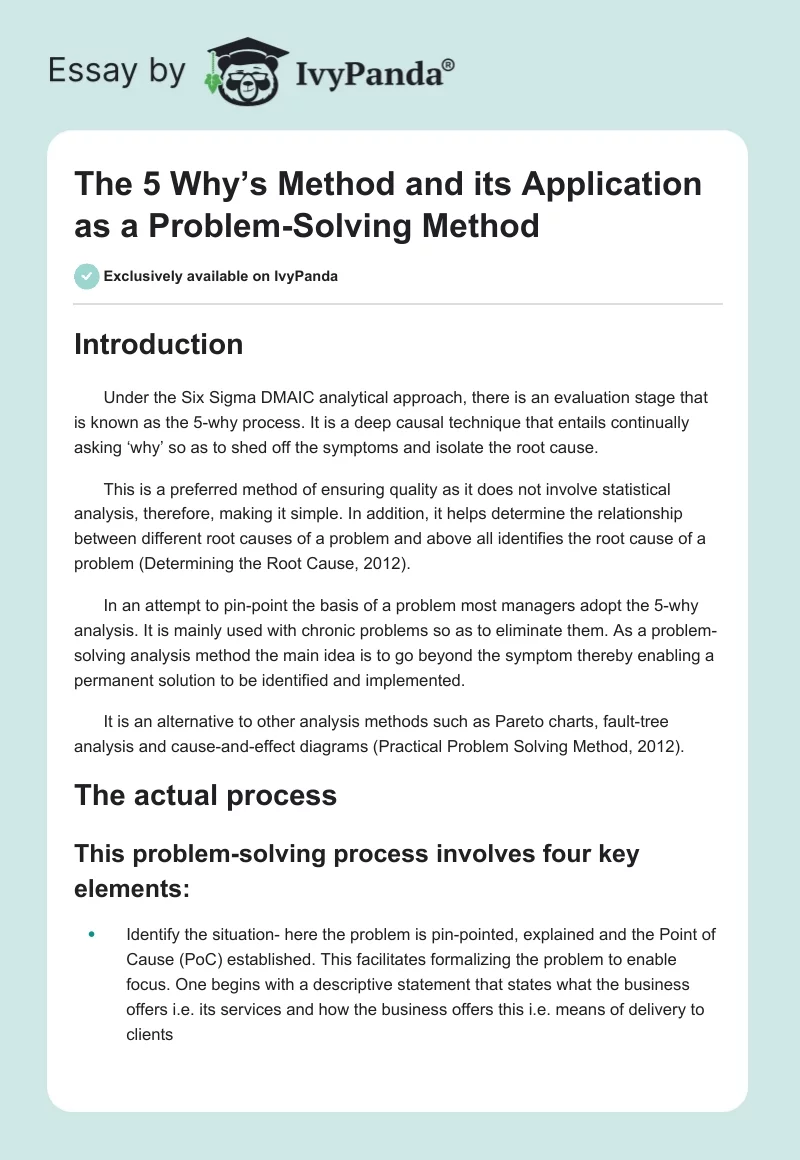Introduction
Under the Six Sigma DMAIC analytical approach, there is an evaluation stage that is known as the 5-why process. It is a deep causal technique that entails continually asking ‘why’ so as to shed off the symptoms and isolate the root cause.
This is a preferred method of ensuring quality as it does not involve statistical analysis, therefore, making it simple. In addition, it helps determine the relationship between different root causes of a problem and above all identifies the root cause of a problem (Determining the Root Cause, 2012).
In an attempt to pin-point the basis of a problem most managers adopt the 5-why analysis. It is mainly used with chronic problems so as to eliminate them. As a problem-solving analysis method the main idea is to go beyond the symptom thereby enabling a permanent solution to be identified and implemented.
It is an alternative to other analysis methods such as Pareto charts, fault-tree analysis and cause-and-effect diagrams (Practical Problem Solving Method, 2012).
The actual process
This problem-solving process involves four key elements:
- Identify the situation- here the problem is pin-pointed, explained and the Point of Cause (PoC) established. This facilitates formalizing the problem to enable focus. One begins with a descriptive statement that states what the business offers i.e. its services and how the business offers this i.e. means of delivery to clients
- Initiate the investigation- here a 5-why investigation is carried out and it entails grasping the root cause for the problem, for why it was not detected early and for why the ‘system’ allowed the problem to occur. The main aim is to find out exactly why the problem happens.
- Problem rectification- here a specific action is taken to at the very least provide a short-term solution to protect the customer.
- Avoidance through error-proofing- this entails ensuring the problem does not persist. Also, the lessons are noted down for future use.
Each of these elements enables a break-down of the problem to answer questions that include who is responsible, what information is lacking, why has not a permanent action been taken and what is the way forward. There is a model known as the 5-why funnel used to break-down the process step-by-step with the three elements, each raising a why question (Determining the Root Cause, 2012).
The first element merely highlights the problem. Alternatively, the 5-why analysis can be combined with the cause-and-effect diagram to illustrate numerous reasons that result in a particular shortcoming.
Conclusion
This process is practical for day-to-day business as it does not have to be used within a Six Sigma project, and its usefulness is felt where the problems being solved involve human interactions. It is also useful because it inculcates a mindset of preventive-action within an organization.
A drawback associated with this technique is that it validates a reality but does not provide a solution for the whys leading to the final basis of the overall problem (Belohlavek, 2011).
It should be noted that although the original purpose was met, this discussion focused on only a small section of the 5-why technique. In this regard, the essay cannot be described as exhaustive as it leaves room for further analysis and evaluation, something that was beyond the scope of the current assignment.
References
Belohlavek, P. (2011). Unicist Business Strategy: Ontology based and Object driven Strategy. Web.
Determine the Root Cause: 5 Whys. (2012). Web.
Practical Problem Solving. (2012).


